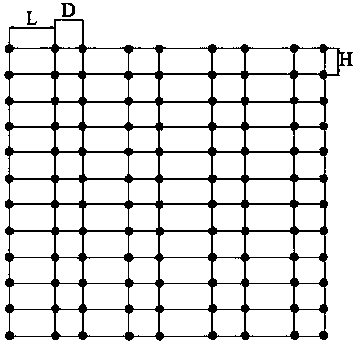Paddy, loach and frog ecological integral planting and breeding method
An ecological and paddy field technology, applied in the field of agricultural breeding, can solve the problems of preventing rice seedling growth, reducing the yield of loach, and not controlling loach, so as to achieve the effects of preventing damage, increasing yield, and avoiding competition
- Summary
- Abstract
- Description
- Claims
- Application Information
AI Technical Summary
Problems solved by technology
Method used
Image
Examples
Embodiment 1
[0033] see Figure 1-2 , a rice loach frog ecological integration method for planting and breeding, specifically comprising the following steps:
[0034] 1) Site selection of paddy fields: The site selection of paddy fields should be in a place with sufficient water source, good water quality, no pollution, convenient drainage, strong water retention and flat fields;
[0035] 2) Construction of the paddy field: The paddy field excavates the ditches 2 along the inside of the ridge 3 in the shape of a "mouth". The ditches 2 have a width of 1.2m and a depth of 50cm. The ridge 3 is 30cm higher than the field surface, and the bottom width of the ridge 3 is 4m. The top width of the field ridge 3 is 3m, a small field ridge 4 with a width and height of 25cm is provided at the junction of the surrounding ditch 2 and the rice planting area 1, a sidewalk 5 is provided on the left side of the paddy field, and water inlets 6 are respectively provided at the opposite corners of the paddy fiel...
Embodiment 2
[0047] A rice loach frog ecological integration planting and breeding method specifically comprises the following steps:
[0048] 1) Site selection of paddy fields: The site selection of paddy fields should be in a place with sufficient water source, good water quality, no pollution, convenient drainage, strong water retention and flat fields;
[0049] 2) Construction of the paddy field: The paddy field excavates the ditches 2 along the inside of the ridge 3 in the shape of a "mouth". The ditches 2 have a width of 1.5m and a depth of 60cm. The ridge 3 is 30cm higher than the field surface, and the bottom width of the ridge 3 is 3m. The top width of the field ridge 3 is 2m, a small field ridge 4 with a width and height of 25cm is provided at the junction of the surrounding ditch 2 and the rice planting area 1, a sidewalk 5 is provided on the left side of the paddy field, and water inlets 6 are respectively provided at the opposite corners of the paddy field And water outlet 7, ...
Embodiment 3
[0061] A rice loach frog ecological integration planting and breeding method specifically comprises the following steps:
[0062] 1) Site selection of paddy fields: The site selection of paddy fields should be in a place with sufficient water source, good water quality, no pollution, convenient drainage, strong water retention and flat fields;
[0063] 2) Construction of the paddy field: The paddy field excavates the ditches 2 along the inside of the ridge 3 in the shape of a "mouth". The width of the ditches 2 is 1.3m and the depth is 50cm. m, the top width of field ridge 3 is 2m, and the small field ridge 4 that width and height are 25cm is provided at the junction of surrounding ditch 2 and paddy planting area 1, and the left side of paddy field is provided with sidewalk 5, and the opposite corner of paddy field is provided with respectively. The water inlet 6 and the water outlet 7, the water inlet 6 is built on the field ridge 3, the water outlet 7 is built on the 8cm pla...
PUM
 Login to View More
Login to View More Abstract
Description
Claims
Application Information
 Login to View More
Login to View More - R&D
- Intellectual Property
- Life Sciences
- Materials
- Tech Scout
- Unparalleled Data Quality
- Higher Quality Content
- 60% Fewer Hallucinations
Browse by: Latest US Patents, China's latest patents, Technical Efficacy Thesaurus, Application Domain, Technology Topic, Popular Technical Reports.
© 2025 PatSnap. All rights reserved.Legal|Privacy policy|Modern Slavery Act Transparency Statement|Sitemap|About US| Contact US: help@patsnap.com


